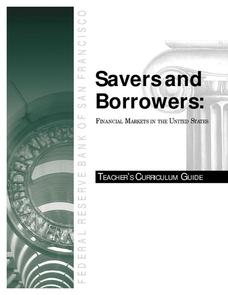Mutualism Teacher Resources
Find Mutualism lesson plans and worksheets
Showing 586 resources
Lesson Planet Curated
Standing Up for Democracy
The mission of the Standing Up for Democracy unit is to bring about “a more humane, just, and compassionate society rooted in democratic values.” These 16 lessons, built on a foundation of mutual respect, tolerance, and participation,...
Lesson Planet Curated
ScienceWeb Australia: Years 9-10
Science Web Australia presents a collection of three units designed for English speaking high schoolers and utilizing resources available online. The first unit focuses on ecosystems, the second on plate tectonics, and the third on the...
Lesson Planet Curated
Unit Four: Land of Giants
The McDonald Creek Valley, located on the west side of the Continental Divide in Waterton-Glacier International Peace Park (W-GIPP), focuses on the two lessons in unit four. In the first activity, scholars explore the role of death in...
Lesson Planet Curated
Unit Two: A Serious Economics Nut
The second unit in the series examines the complex relationships between animals and plants in the whitebark pine community of Waterton-Glacier International Peace Park. In the first of five lessons, scholars mimic Clark’s Nutcracker...
Lesson Planet Curated
Glacier National Park Curriculum
Waterton-Glacier International Peace Park (W-GIPP), chartered in 1932, is the first international Peace Park globally and spans the Canadian United States border. Five units introduce learners to political and environmental factors that...
Lesson Planet Curated
Crash Course: Ecology
Viewers take a Crash Course in Ecology with a 12-video collection that takes a look at where organisms come from, how they interact, and how they influence their environments. The videos, appropriate for in class or remote learning, use...
Curated OER
Savers & Borrowers: Financial Markets in the United States
Investigate the current financial market and have your class explore savings, borrowing, financial markets, mutual funds, and the stock market. This four-part lesson is designed to help students become knowledgeable and informed consumers.
Curated OER
The Flower and the Fly
It's like a biological "Beauty and the Beast!" The fascinating mutualism between a South African meganosed fly and a deep-throated geranium builds a case study in coevolution for your biology buffs to analyze. After reading about this...
Scholastic
Study Jams: Symbiosis
Three types of symbiosis are explained: parasitism, commensalism, and mutualism. This is done with colorful animation and lively dialogue in a straightforward and easy-to-follow manner. Have your ecology class watch this at home and then...
Curated OER
Mutual Inductance
In this mutual inductance learning exercise, students answer 12 questions about electric currents, voltage, magnetic coupling, and magnetic flux as they relate to inductance.
Deep Look
The Double-Crossing Ants to Whom Friendship Means Nothing
I'll scratch your back, if you'll scratch mine—unless someone else comes along that is a better scratcher! Examine the fickle nature of rainforest insects using a captivating video. The narrator describes the mutualistic relationship...
Curated OER
Friend, Foe, or . . .
As a result of this lesson, upper elementary ocean explorers will be able to describe several interrelationships: symbiosis, mutualism, commensalism, and parasitism. They learn that the biological richness is increased near seamounts and...
CK-12 Foundation
Symbiosis: Mutualism, Commensalism, and Parasitism
Hyenas normally hunt alone, however scientists discovered that in Israel, hyenas hunt with wolf packs. When relationships develop between different species, we call it symbiosis. The videos teach about the three types of symbiosis and an...
Bozeman Science
Populations
The largest concentration of free-roaming wildlife in the continental United States is found in Yellowstone National Park. A video describes the three main types of population interactions: mutualism, commensalism, and parasitism. It...
Curated OER
Sixteen Mutually Exclusive Probability Problems
In this mutually exclusive probability worksheet, students solve for the probability of sixteen mutually exclusive events. A short explanation is provided. Additionally students can find hints and check their solutions by...
Be Smart
How Bees Can See the Invisible
What do bees use to get rid of tangles? A honey-comb! The video focuses on how bees instinctively find flowers — their eyes view the world differently than ours. They also seem to be guided by electric charges because the bees have a...
CK-12 Foundation
Mutually Exclusive Events: Lemon Roulette!
You first! An interactive sets up a game between two friends who hope they don't find a lemon hidden under a tray. Pupils determine whether there is an advantage of going first. Individuals find the probabilities of each friend finding...
CK-12 Foundation
Mutually Inclusive Events: Flower Beds at the Community Garden
What color does your garden grow? Learners manipulate the number of flowers of two colors in two garden plots. They determine the probabilities of choosing a particular color of a flower in a given plot. Scholars find the relationship of...
Nuffield Foundation
Nitrogen-Fixing Bacteria in Root Nodules of Leguminous Plants
Fixin' to add a great resource to your plans? Scholars perform an experiment to investigate nitrogen-fixing bacteria from plant roots. Along the way, they learn about the concepts of symbiosis and mutualism.
Curated OER
Symbiosis: Helped, Harmed, or Neither?
In this symbiosis worksheet, students will brainstorm 2 examples of each different type of symbiotic relationship which includes mutualism, parasitism, and commensalism.
Curated OER
Symbiosis
In this symbiosis worksheet, students complete a graphic organizer about the three types of symbiosis. They define commensalism, mutualism, and parasitism and list the important things to remember about each.
Curated OER
Populations
Every species in the world has some type of relationship with another species, whether it be positive, negative, or neutral for each party. Mr. Andersen defines each type of relationship and provides clear examples under each category....
TED-Ed
You and Your Microbes
Humans are like planets, hosting a plethora of microbial communities. This concept is explored with vivid narration and animation, bringing to light the benefits of the huge variety of microbes that live in and on our bodies. What a fun...
Curated OER
Interactions of Living Things
Is it a producer, carnivore, omnivore, scavenger, or decomposer? Different relationships among organisms are explored here. It is a simple, multiple choice assignment. Use it as a quick warm-up or quiz.
Other popular searches
- Symbiosis & Mutualism
- Symbiosis and Mutualism
- Mutualism and Commensalism
- Mutualism Parasitism
- Symbiosis Mutualism
- Competition Mutualism
- Mutualism, Commensalism
- Commensalism, Mutualism
- Symbiosis, Mutualism
- Commensalism Mutualism
- Mutualism, Parasitism
- Symbiosis Mutualism Video

























